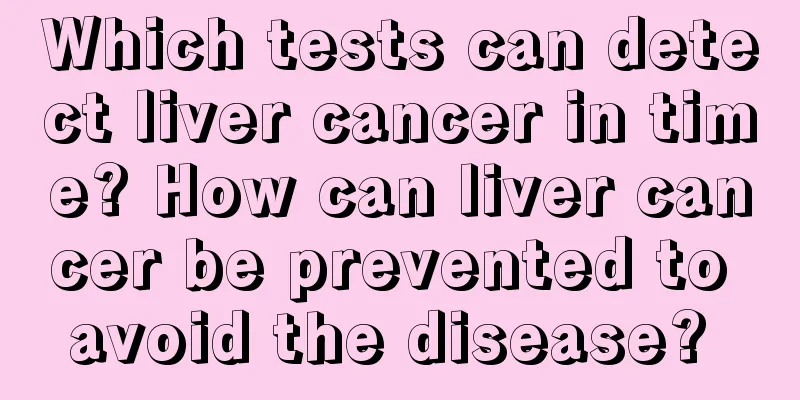Which tests can detect liver cancer in time? How can liver cancer be prevented to avoid the disease?

|
Nowadays, due to some unhealthy diets, work and rest habits, the number of liver cancer patients is obviously on the rise. People are terrified when they talk about cancer. In fact, if liver cancer is discovered in time, the cure rate is still very high. However, 80% of patients do not know how to diagnose liver cancer early. They only go for examinations after experiencing obvious liver cancer symptoms such as severe loss of appetite, weight loss, ascites, pain in the liver area, and a mass in the right upper abdomen. The results show that the disease is already in the late stage. Therefore, early diagnosis of liver cancer is very important. Here are some relevant knowledge about the early diagnosis of liver cancer to help you learn and prevent it better. So, how to detect and diagnose early liver cancer? 1. Do an alpha-fetoprotein (AFp) test: AFP is a special protein contained in the human blood during the embryonic period. It is synthesized by embryonic liver cells, yolk sac, thymus and gastrointestinal tract. Its concentration gradually increases from the beginning of pregnancy, reaches a peak at 2 to 15 weeks of pregnancy, and then gradually decreases until it disappears one week after the birth of the newborn. Once a person has liver cancer, alpha-fetoprotein will reappear in his body, and the concentration is tens to tens of thousands times higher than that of normal people. As the basis for the diagnosis of primary liver cancer, AFp has an accuracy rate of up to 60% to 70%. 2. Do B-type ultrasound examination: Since AFp is not detected in about 30% of liver cancer patients, B-type ultrasound examination is needed to make a clear diagnosis. According to statistics, the combination of alpha-fetoprotein examination and B-type ultrasound examination can make a clear diagnosis of 98% of early liver cancer patients. 3. CT examination: CT has greater advantages in diagnosing liver cancer. It can clearly determine the location, number, size of the tumor, and the relationship between the tumor and surrounding tissues. It is especially valuable in clarifying the nature of the tumor. 4. Detection of α-L-fucosidase: In recent years, with the continuous advancement of medical technology, a new detection item, α-L-fucosidase (AFU) detection, has begun to be used clinically. This enzyme is widely distributed in various organs of the human body, but the AFU content in liver cancer patients will increase. Clinical experience shows that the increase in AFU has nothing to do with the size of the tumor. As long as there are liver cancer cells growing in the patient's body, the AFU content will increase. 5. Do liver angiography: With the emergence of angiography technology, especially digital subtraction angiography, it has been widely used in the diagnosis of liver cancer in clinical practice. Liver angiography can not only determine the location, size, number and distribution range of liver tumors, but also understand the number of blood vessels on the tumor, thus providing a basis for the treatment of the disease. This examination is particularly important for the localization diagnosis of small liver cancers, with an accuracy rate of more than 90%. In addition, this technology can also be used clinically to perform embolization, perfusion and other treatments on the tumor site. How to prevent liver cancer? Daily prevention guide for liver cancer 1. Prevent hepatitis: Using hepatitis vaccines to prevent hepatitis and thus liver cancer has become one of the most promising ways to prevent liver cancer, but it is estimated that it will take decades to see results. It has been proven that hepatitis B vaccines are effective in preventing hepatitis. However, from a comprehensive perspective, prevention of HCV and HDV still needs to be considered. In addition to injecting hepatitis B vaccines, prevention of viral hepatitis also requires attention to the control of other transmission routes, such as diet, surgery, blood transfusion, injection, acupuncture and hairdressing. 2. Grain mold prevention: Mainly for corn and peanuts that are easily contaminated by AFB1. Moisture-proof storage is carried out during grain harvesting, threshing, transportation, drying, storage, etc. Grain that has been obviously moldy cannot be eaten; grain that is extremely mildly moldy is carefully selected, cleaned, and treated with drugs. In high-incidence areas, it is recommended to change the dietary structure and reduce the proportion of corn in the staple food. 3. Improve drinking water: In rural areas with high incidence, adopt a variety of measures in conjunction with the patriotic health campaign to improve the drinking water environment. Change from drinking ditch and pond water to drinking well water, deep well water, and rainwater, or build small water plants. Cities should use unpolluted water sources as the source of tap water and prevent environmental pollution. 4. Appropriate selenium supplementation: For people with low selenium level, use selenium-rich yeast, selenium polysaccharides, and selenium-rich salts to supplement selenium and increase blood selenium levels. |
>>: What foods can cause liver cancer? Dietary considerations for liver cancer patients
Recommend
Diet for patients with lymphoma during recovery
When recovering from treatment, patients with lym...
How to drain menstrual blood during menstruation?
Generally speaking, a woman's menstrual perio...
There are many small bumps on my calves which are very itchy
There are many small bumps on the calves that are...
Can fresh lotus seeds be frozen
The lotus seeds we eat in daily life are usually ...
Tuberous sclerosis complex, beware of these characteristics
Tuberous sclerosis complex can attack multiple or...
How to check and treat nasopharyngeal carcinoma
What are the treatment and examination methods fo...
What are the traditional Chinese medicines for treating ovarian cancer? These 4 traditional Chinese medicines can treat ovarian cancer
There are many traditional Chinese medicines for ...
Why is my throat itchy deep in my ears?
The throat and ears are closely connected. The th...
Is it necessary to take lenvatinib in the middle and late stages of liver cancer? Pay attention to these matters when taking liver cancer medication
Lenvatinib generally refers to lenvatinib mesylat...
Is the high incidence of esophageal cancer inherited from generation to generation?
Is esophageal cancer inherited from the previous ...
How to fix an ugly mouth
The mouth is one of the five senses of a person. ...
What are the effects and functions of blue chalcedony?
Because of its different composition, chalcedony ...
What is Skin Cancer
The biggest enemy of modern medicine is cancer, a...
What are the effects and functions of pennywort?
You may not know much about pennywort. It is a gr...
How long can you live with pancreatic cancer
How long can you live with pancreatic cancer? Thi...









